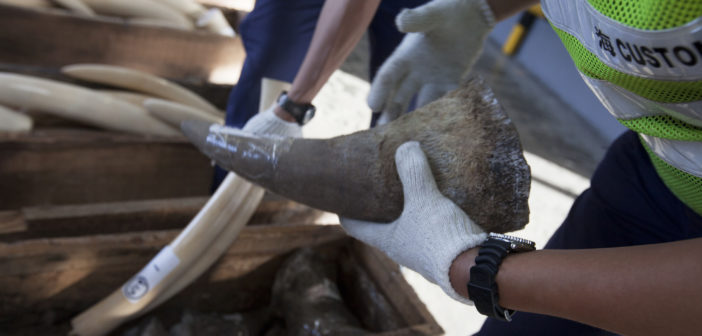Content warning: The above video contains a few images of dead and dismembered animals.
LONDON— An undercover investigation has revealed that Vietnamese criminal syndicates are becoming increasingly prolific, presenting a fast-growing threat to already besieged populations of elephants and other endangered wildlife.
Exposing the Hydra: The growing role of Vietnamese syndicates in ivory trafficking documents the findings of a two-year investigation by the London-based Environmental Investigation Agency (EIA).
Successfully infiltrating several ivory trafficking syndicates and gaining the confidence of key players, EIA investigators were able to construct a comprehensive picture of how these criminal organizations are structured, how they cooperate with one another and how they diversify to traffic other endangered species such as rhinos and pangolins.
Illegal traders identified in Exposing the Hydra revealed that at least 22 successful shipments of ivory from Africa, potentially worth $14 million, had occurred between January 2016 and November 2017. This staggering amount of illegal ivory trading was facilitated by bribery and corruption at the highest levels.
In contrast to China, which closed its domestic legal ivory market in January and prioritised enforcement against ivory trafficking, the government of Vietnam has not demonstrated serious commitment to tackling wildlife trafficking.
Vietnam’s failure to enforce laws and tackle corruption has enabled the country’s organized criminal syndicates to expand rapidly; if their growth continues unchecked, they could fill the void left by Chinese syndicates, which have ceased operating due to improved enforcement in China and some parts of Africa.
Mary Rice, EIA Executive Director, said “It is deeply concerning that Vietnam, which hosted the high-level international Illegal Wildlife Trade Conference in 2016 and claims to have made great progress in tackling the issue, is in reality a primary and fast-growing hub for ivory trafficking and the illegal wildlife trade. Vietnam has made repeated promises under the Convention on Illegal Trade in Endangered Species to tackle ivory and rhino horn trafficking, but to date these remain empty words. Instead, the past decade has seen Vietnam serve as a prominent transit route for large ivory shipments to China as well as overseeing a growing carving industry and one of the world’s biggest markets for ivory sales.”
EIA’s database of ivory seizures reveals that since 2009, 56 tons of ivory have been seized in Vietnam and a further 20 tons linked to Vietnam have been seized in other countries. Likely representing a small fraction of the actual volume trafficked, these amounts alone represent as many as 11,414 dead elephants.
The Vietnam investigation revealed several major criminal syndicates operating in Mozambique and other African countries, which traffic wildlife into and through Vietnam. They are loosely structured with distinct and hierarchical roles, but with flexibility to co-operate or switch affiliation.
Unlike the Chinese criminal groups EIA has previously investigated – such as the one exposed in the 2017 report The Shuidong Connection – the Vietnamese gangs are prepared to be more hands-on, sending out agents to other countries to personally supervise the packing and dispatch of contraband and using a variety of sophisticated concealment methods such as hiding tusks in hollowed-out logs, blocks of fake stone or innocuous goods such as beans.
Specialist transporters are used to move the goods along multiple routes, and corruption is a feature along the entire trade chain. For example, one syndicate member told EIA investigators he has several customs officials at Malaysia’s Johor port on his payroll; another major trafficker explained she had to pay bribes along the entire trafficking route from Laos to Vietnam.
While investigating several of the dozen or so separate syndicates operating between Africa and Asia, EIA investigators were able to identify a common structure, with each topped by a syndicate head who oversees the group, recruits transporters and workers, builds connections with corrupt officials and makes high profits.
Beneath the head are specialist transporters who move consignments across borders and close connections to corrupt officials, then independent operators able to source ivory and other wildlife from Africa and, finally, workers – also known as ‘soldiers’ – employed in source countries to collate, pack and dispatch ivory; this last tier also includes ‘pilots,’ recruited by syndicates to bring back contraband as passengers on international flights.
“As concerning as the situation is in Vietnam, this is not a lost cause,” added Rice. “Better enforcement is already making a big difference in illegal trade hotspots such as Tanzania and China – now it’s time for Vietnam to step up and take bold action.”
Read the summary of the investigation and the entire report here.
Featured image: Seized ivory tusks, rhino horn and leopard skin at the Hong Kong Customs and Excise headquarters in Hong Kong, China, 2013. Image credit International Fund for Animal Welfare, CC BY-SA 3.0.







